Postcard from Potsdam
I’ve just returned from the State University of New York in Potsdam after participating in a fascinating festival on the French composer, conductor and pedagogue, Nadia Boulanger.
 When founded by the redoubtable Julia Crane in 1886, the Crane Normal Institute of Music was small enough to be run in the living rooms of a house on the town’s main street. Today, the Crane School of Music at SUNY Potsdam is a flourishing institution that boasts more than 500 undergraduate music majors. A key architect of the School’s success was Helen Hosmer, a 1918 graduate who returned to join the Crane Institute staff in 1922. In the summer of 1925, Hosmer went to study at the Conservatoire Franco-Américain at Fontainebleau, where she fell under the spell of the charismatic Nadia Boulanger. Hosmer became the director of Crane after it was acquired by the state of New York, and during her tenure (1930-1966) she brought international guest teachers and conductors – including Nadia Boulanger – to Potsdam to work with her students. In this year of SUNY Potsdam’s bicentennial, the spring festival on Boulanger was a great opportunity to celebrate some of the influential women in music who played such important roles in shaping the institution.
When founded by the redoubtable Julia Crane in 1886, the Crane Normal Institute of Music was small enough to be run in the living rooms of a house on the town’s main street. Today, the Crane School of Music at SUNY Potsdam is a flourishing institution that boasts more than 500 undergraduate music majors. A key architect of the School’s success was Helen Hosmer, a 1918 graduate who returned to join the Crane Institute staff in 1922. In the summer of 1925, Hosmer went to study at the Conservatoire Franco-Américain at Fontainebleau, where she fell under the spell of the charismatic Nadia Boulanger. Hosmer became the director of Crane after it was acquired by the state of New York, and during her tenure (1930-1966) she brought international guest teachers and conductors – including Nadia Boulanger – to Potsdam to work with her students. In this year of SUNY Potsdam’s bicentennial, the spring festival on Boulanger was a great opportunity to celebrate some of the influential women in music who played such important roles in shaping the institution.

I was invited as a special guest for the Boulanger weekend to talk about my book The Musical Work of Nadia Boulanger: Performing Past and Future Between the Wars (CUP, 2013). The other special guest was my friend and colleague Dr Kimberly Francis of the University of Guelph in Canada, author of Teaching Stravinsky: Nadia Boulanger and the Consecration of a Modernist Icon (OUP, 2015). Kimberly and I are working together on an edition of the selected writings of Nadia Boulanger, so the festival gave us a great chance to do some work together as well as catching up.
The weekend’s programme included a great mix of teaching, performance and presentations. Professor Donald George, who masterminded the event, is in the process of recording the complete mélodies of Nadia Boulanger, including some that were never published or which were revised after publication. A highlight of the weekend was the concert by Crane vocal faculty of these works. The performances (including by Donald himself) were stunning, and it was particularly interesting to hear the songs in chronological order and to listen through Boulanger’s development as a composer. Works like Elégie (1907) and Cantique (1909) are fine songs that bear the imprint of Boulanger’s compositional training with Fauré in their expert deployment of modal inflection and fluid modulation. By the time we reach her settings of five poems by Camille Mauclair (1921), Boulanger had adopted a more astringent language. I really liked these songs and wish they were performed more often.


Kimberly and I made symposium presentations of our research and also worked with Crane students in Theory IV, Women in Music, and Music History classes. Kimberly showed the music theory students Boulanger’s annotated scores of works by Webern and Bartók, and led a great discussion of the historical development of techniques for analysing serial music. Boulanger’s analyses have one foot in tonal techniques while showing a clear awareness of serial procedures and the effort to devise analytical means to account for them. The students found this discussion fascinating and I learned as much as they did. For my part, I worked with Music History and Women in Music students on Boulanger’s early career, looking particularly at her relationship with Fauré both as his pupil and as an influential advocate for his work.
In addition to all this, we heard performances of other Boulanger works including the modern premiere of two SSAA choral pieces and three short piano works from her early career. Audio engineer emeritus Gary Galo gave us a great presentation of Boulanger’s appearances in the Crane archive of recordings, which holds renditions of some pieces she never recorded commercially. The highlight for me was the archive recording of NB’s 1941 concert at Carnegie Hall with the Crane Chorus and New York Philharmonic, which included an excellent performance of the Fauré Requiem. Boulanger considered this as a masterpiece and studied it with generations of students, including Helen Hosmer – who herself became an influential advocate for the piece in North America.

In down time from the festival activities, Kimberly and I visited the Crane archives and worked with boxes of Helen Hosmer and Nadia Boulanger’s correspondence. We also made a trip to the nearby Bayside cemetary to see Hosmer’s grave. This is not actually as creepy as it seems, as Hosmer instructed that the opening of the ‘Pie Jesu’ from the Fauré Requiem should be carved on her tombstone and I thought this was a particularly fascinating example of the reception of the piece. (Not ghoulish: scholarship!) We got lost every single day, but fortuitous encounters with helpful Crane students who escorted us to concert halls, libraries and even the tombstone made even that a fun experience.
We had a packed four days but it was terrifically inspiring and enjoyable – kudos to Donald George, his colleagues and students at Crane for a wonderful event.


